Many guitarists aspire to play the blues. Some even get there. Blues is a deceptively simple musical style that relies heavily on a lot of a common vocabulary and each player’s individual creativity with it.
The mistake many beginning guitarists make is to think of blues playing as just a bunch of chords that they can simply play their Minor Pentatonic patterns up and down across and call it a day. That’s why there is so much bad blues playing in the world.
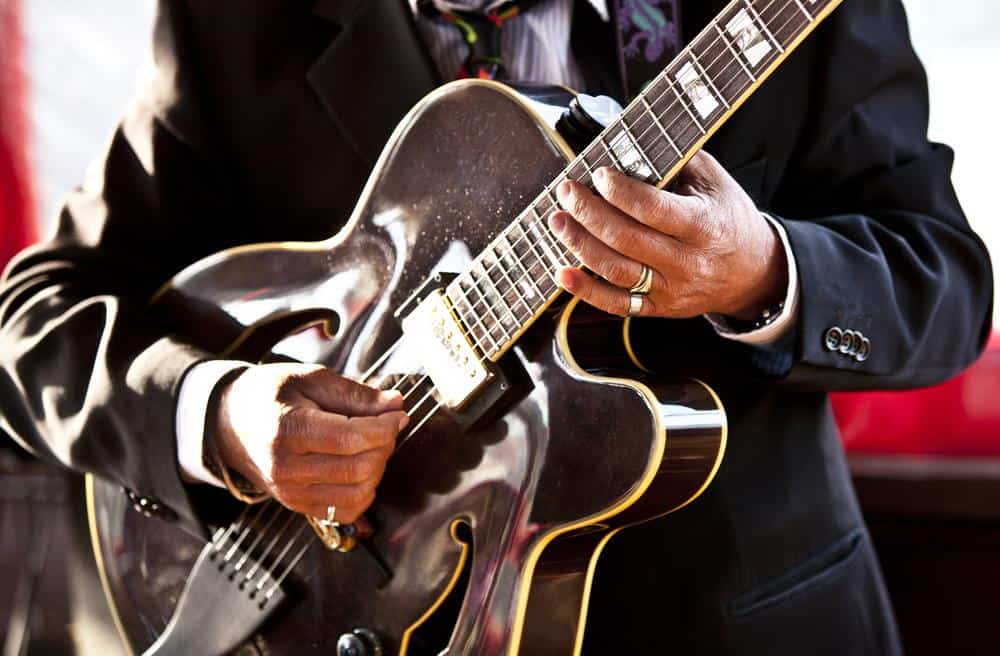
Blues music is a shared language that can be learned if approached the right way. After you learn your basic 12-bar chord progressions, your next task is turning your Pentatonic scales into musical phrases or riffs.
Think of this as a kid going from just saying the alphabet over and over to actually turning it into words and sentences. A riff or phrase is nothing more than a musical sentence. Some are long and complex and others are short and to the point.
Before Trying Some Riffs:
The words ‘riff,’ ‘lick,’ and ‘phrase’ all mean the same thing and are often used interchangeably. Don’t let the jargon confuse you. Think of them as musical sentences and you will do just fine.
In this article, we will look at a number of easy blues riffs that we all play in one way or another. These are basic building blocks that are under the fingers of every player in your record collection.
As you start to play through them, you will hear sounds that you’ve heard come from greats like B.B. King, Magic Sam, Buddy Guy, and Stevie Ray Vaughn. Once you learn them, learn to sing them to get them into your ears as well as your fingers.
After that, make your own variations on them by adding or subtracting something to them. This is how you develop your own style.
How To Master The Blues Riffs Easily
1. Starting Slow With Power Chords
Power chords are extremely easy to play, which is why we picked them off as our starting point. In case you don’t know what a power chord is, it’s a shortest chord type which is composed of two notes (which are always 7 semitones apart).
Now, if you’re going to use power chords in blues, you’ll want to remain in a “blues” scale. We’ll talk about them later, but for now, all you need to know is that they usually “sound happy”. If you play power chords with a gloomy, dark atmosphere, you’ve stepped off into a different scale.
As an example, let’s see the “Good Ol’ fashioned dirty blues rock” tab:

As you can see, we have a 4-bar riff comprised of two 1/4 notes, two 1/8 notes, and a pause in the duration of a 1/4 . We’re looking at the A power chord, which progresses into G, later F, and ending in the E.
If these power chords are too complicated for you, you can easily cut down the notes on the “D” string (3rd string from the bottom) – it will be much easier to play while sounding pretty much the same.
2. Using Slides, Legato
Now that you’ve handled the power chords, it’s time to step it up with the slide, legato (hammer-on and pull-off techniques). Basically, these guitar techniques are used in nearly all music genres, and blues guitarists in particular have some strong love for them.
In fact, they like it so much that a special guitar was designed specifically for blues players – the slide guitar. Without going too much into detail, let’s first discuss how these techniques are used before we use them to make an easy blues riff.
- Pull-off – Hold down two notes at the same time, pluck or pick the string they’re on and “pull off” one of the two fingers holding the notes

Here we have another 4-bar riff, again starting from the A power chord. The first three notes on every bar are “A-G-A”, followed by the “D-E” hammer-on and pull-off.
At the second bar we’re looking at the “A-G-A” notes followed by the “upward” slide from the “D” note to the “E” note.
The third bar is the same as the first, and the last bar is different from the second – there’s a “downward slide” from the “E” note to the “C” note.
3. Try Pentatonic Scale
There are numerous variations of the pentatonic scale, but for the sake of making the most comfortable easy blues riffs, let’s take the 12th fret as our starting position. We recommend that you use this scale when making solos, intros, or outros, but don’t take it as a rule.

One of the most common ways of using the pentatonic scale is for practice. You can warm up before going straight into playing easy blues riffs, or you could jam while perfecting your technique and style.
4. Play Chromatic Scale
Some musicians refer to the “chromatic” scale as the “blues” scale, as it is most commonly used in this music genre. Basically, this scale is comprised of notes that are a single semitone apart from the previous, unlike the usual 2-semitone difference. Let’s see it on picture for clarification.
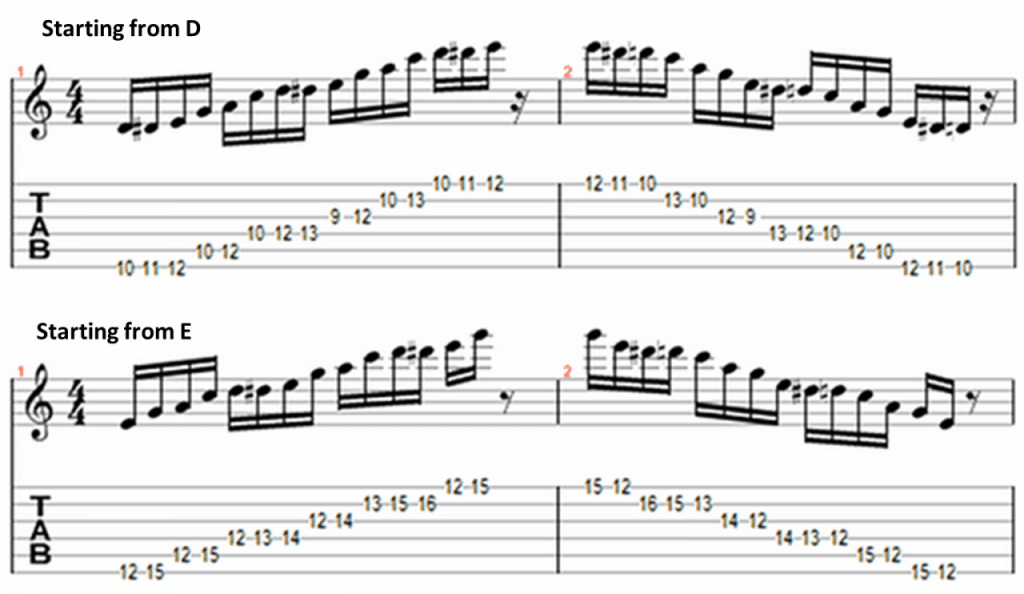
As you can see, the first two note pairs are played with the 3-semitone difference between them while the third note pair (12-13-14) is played with notes right next to each other. This is the so-called “chromatic” pitch in the bleus scale which makes it different from the usual pentatonic and hexatonic scales.
The reason why you should play around with the chromatic scale is because you’ll be able to express your blues more profoundly. Basically, as long as you play everything “by the book”, you won’t get the bluesy feel which only the “chromatic” scale offers.
Now, as the image we’ve provided might be too complicated for beginners, let’s see an easier variant you could try out if you’ve just started playing blues:

There’s nothing wrong with experimenting either – as long as you feel the riff sounds good. The easier variation of the easy blues riff in the picture above is comprised of two bars in the regular major scale, with the last 2 bars being played in the chromatic scale.
The reason for this is quite simple – you should either go straight ahead and open the riff with a chromatic scale licks or end it with them, this way you’ll accentuate the blues feel. If all bars have notes in the chromatic scale, you might end up playing progressive music.
5. Easy Blues Riffs In Solo
You have the option of creating your own solos or following up as the rhythm, but it’s imperative that you’re in the same scale as the other part. For the sake of simplicity, let’s break this down in two segments:
Making Easy Blues Solos
Simply put, you should combine everything you’ve learned so far, but it’s important not to overdo it. Blues solos are often pretty slow and packed with feelings, instead of heavy technique abuse. We recommend that you start off with some vibratos, get a couple of slides here and there, hammer on when you deem necessary, and experiment around the “blues/chromatic” scale.
Making Easy Blues Rhythm Licks
It’s up to you to decide whether you’re going to follow with power chords, plain chords, single notes, or licks. We’ve discussed what power chords are, the “plain chords” are note combos (such as A-chord, barre-chords, and such) while the “single notes” represent plucking or picking a single fretted string.
Rhythm licks, on the other hand, are more complicated. They’re usually combinations of several techniques, but still far simpler when compared to actual solos. A good example of a blues lick would be:
Learn From The Best
Listening to blues will be more helpful than spending hours searching for easy ways on online sites. That’s why we’ll recommend learning from the best, such as B.B. King, Muddy Waters, Buddy Guy, Stevie Ray Vaughan, Jimi Hendrix, and Eric Clapton.
1. B.B.King
Apart from being a master lyricist, the Riley King is a songwriter and a producer. You’ll easily spot the difference between him and other musicians, as his songs are filled with mini solos all around. He plays the “Lucile”, which he also sung about on occassions.
Riley’s signature move is the accentuated “vibrato” technique. Most riffs he’s using revolve around 3-4 stringed notes, which, more often than not, end with a heartfelt vibrato.
Since he’s singing and playing at the same time, he usually begins the tact with a single note, which is just enough to contribute to the atmosphere.
2. Muddy Waters
McKinley Morganfield is definitely one of the big guys you should definitely listen to if you want to get your blues up and runnin’. His style is peculiar in all aspects, as he’s able to mix sunshine with rain in the same song, leaving out the rainbow under the heavy blues solos.
Most of his songs are quite plain, but all the more memorable. One of his most famous works is the Hoochie Coochie Man.
Muddy gets his bluesy sound with heavy slides and hammer-on techniques. Most of his guitar licks can be found in the A minor pentatonic scale, including the “Manish Boy”, “After the Rain”, and “Rock me”.
One of his simplest blues riffs is covered in this video below – essentially, it’s a root “A”, followed by a simple power chord with stop action, so check it out if you’d like.
3. Buddy Guy
Georgy Guy was an idol for a number of blues stars, like Hendrix, Ray Vaughan, and Clapton, and rightly so, if we may add. Buddy’s songs are something you must hear before you realize they’re indescribable, as they’re as blue as can be.
Plainly put, songs like “What Kind of Woman is This” and “Somebody is sleeping in my bed” are his most recent ones, and they’re nothing less than a proof that Buddy remains one of the godfathers of blues. He’s one hell of a guitarist and unparalleled when it comes to singing.
In general, blues is quite slow, but Buddy often gets quite upbeat with his songs. Pete Farrugia demonstrates the “five essential buddy guy guitar riffs”. This video will show you how unique and distinct Buddy Guy’s playing style is, and, even though most of these licks are quite plain, they’re exquisite all the way.
8 Easy Blues Riffs For You
1. The King
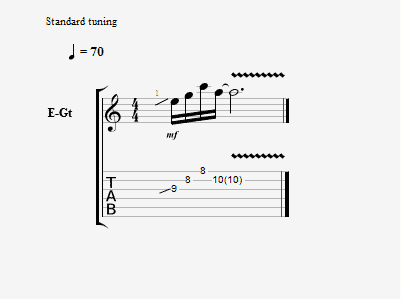
This is one of the first licks we all learn and is classic B.B. King magic. Use it to open a phrase over the Major chord. It creates a strong Dominant 7th sound, as do many blues ideas and ends a bit of musical tension that’s absolutely delicious.
KEY:
Visualize it as based on the first position of F Major chord that all beginners hate and move it around to different keys.
The example is in the key of C. Move it to other keys by putting the root note, (in this case the C on the 8th fret of the high E string) on a different fret/note on the same string to play it in other keys.
Move the lick up and down one fret at a time to get the feel for this.
2. The Wolf Howl
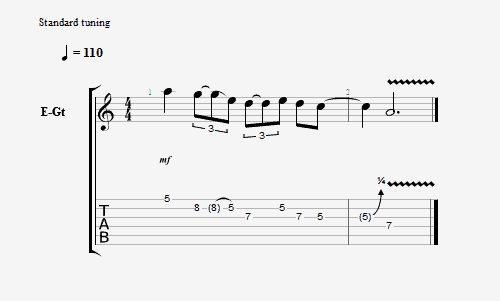
This is a stock Minor Pentatonic lick in the key of A. It is very much in the style of Hubert Sumlin, guitarist for the great Howlin’ Wolf. The tonality is Dominant 7th all the way.
Get this learned and start changing things around to be the way you want to hear them. Every blues player in the world knows this lick and it is time for you to join the club! Move your scale pattern (and the lick within it) to different frets to play in different keys.
3. The Rollover
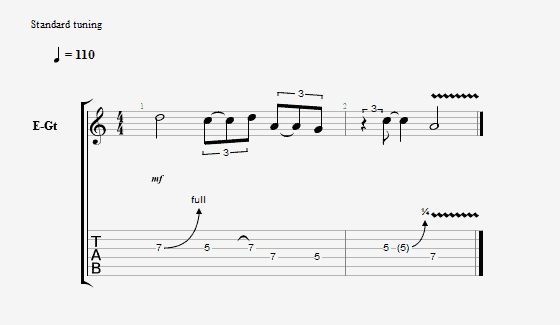
This one is a close relative of Lick 2, also in A, and includes a semi-tricky Third Finger rollover to play the 7th fret notes on the G and D strings.
Resist the temptation to do the same thing with your first finger on the next two notes because a rollover won’t leave you in a good position for the required small bend. Replant and use the tip of your first finger for the bend.
4. The Albert King Bend
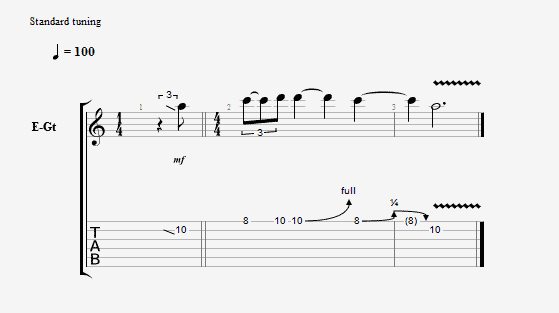
Riff 4 is also in the key of A but is up one octave from its close cousin in Riff 3. It is the same box shape just over two strings and up two frets. It has a cool Albert King-like quality that vibes with just about anything. It’s a simple lick but you have to play it like you mean it for it to work!
The tough part here is being able to bend the first string up and then bring it back down silently. String muting is your friend!
5. The Hammered Third
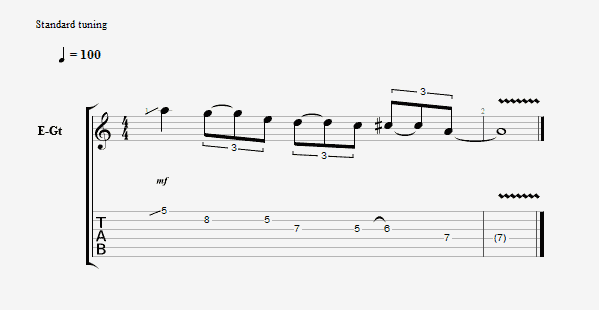
Riff 5 takes a trip down the old Minor Pentatonic pattern we all love but adds in a hammer-on note on the 6th fret of the G string that gives it an unmistakeable A7 sound.
Technically, you are hammering from the Minor Third (C Natural) to the Major Third (C#), which is an essential blues guitar move. A lot of blues playing includes both Thirds like this and it is a hallmark of the style. Just be sure to use this over A7 and not A Minor or you might have a fight on your hands.
6. The Flat 5 Stevie

Riff 6 goes straight to the heart of Em7 but can also work over E7 if handled correctly. The cool part of this one is that it tags the Flatted 5th/Blue Note (Bb here) twice in two octaves for an extra serving of grease. Stevie Ray Vaughan used this position extensively. See if you can spot it near the end of the opening chorus of “Pride and Joy.”
7. The Minor Miracle
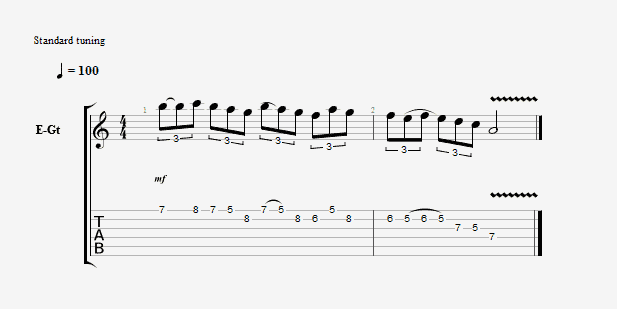
Riff 7 takes us firmly into in Am7 with a lick based on the A Minor Scale fingering that our favorite Pentatonic shape is extracted from. This one works in either Minor Blues or Latin situations and is more in the style of Carlos Santana than it is SRV.
It has a lot of notes in it but that just gives you more possible variations of it to invent. Play this one expressively and it will carry more weight than if you merely shred through it.
8. The Big Bend
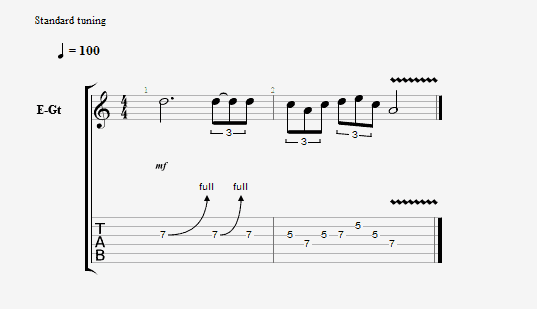
Riff 8 takes us right back to the Minor Pentatonic scale. The difficult part here is the two-fret bend on the G string that opens the lick.
The two-fret or whole step bend is the one we use most often and it is vital for you to be able to do it in tune. Poor bending technique is one of the quickest ways to make an electric guitar sound terrible, so be sure to put in your time on this one.
TIPS!
The best hack is to practice by playing the 9th fret note on the G (that is your target tone) and then backing off to the 7th Fret and matching the fretted pitch with the bent one.
Remember that all of these riffs are only starting points and patterns to learn. None of them are that tough but all are essential to the Blues Guitar style. The big error most students make with learning licks like these is not practicing them until they are as fluent as the language you speak every day.
When you have these licks learned as well as you do noun and verb agreement, the variations will flow out of you a lot more naturally and you will start sounding a lot less like a beginning student.
Conclusion
As Keith Richards said, “If you don’t know the blues, there’s no point in picking up the guitar”. This might sound harsh, but it’s true to the core. Hendrix understood what Keith meant when he said that “Blues is easy to play, but hard to feel”. This is what the purpose of learning the easy blues riffs is – as soon as you get the bluesy feel, you’ll get to understand the very heart of music.
We hope you enjoyed this article on Easy Blues Riffs and that you learned a bunch of useful stuff from it. Please let us know your thoughts in the Comments section. Start thinking of Blues as a language with a vocabulary of phrases that can be learned and built upon and your playing will improve quickly.